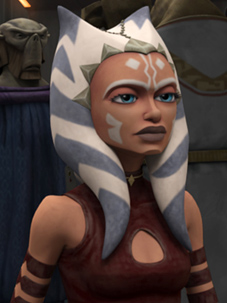Because Jar Jar Binks was unpopular among fans and took on a lesser role after Episode I, the next two movies lacked a protagonist whose fate was unknown. With Padme and Mace Windu, and especially Anakin, Obi-Wan and Yoda, we weren’t watching so much for “what happens” to the characters but rather for “how it happens.”
That could’ve been even more of a problem in “The Clone Wars,” which bridges the gap between Episodes II and III, especially now that the series is progressing chronologically rather than as a series of vignettes. The solution George Lucas and his team came up with was Ahsoka Tano, Anakin’s teenage Padawan.
But even though she fills the quota of “one character whose fate we don’t already know,” and even though she appeals to young girls — a demographic that “Star Wars” hadn’t actively gone after in the past — Ahsoka didn’t go the route of Ewoks or Jar Jar. Fans have not only accepted her as part of the saga, but they actually like her. Part of that is due to the performance of voice actress Ashley Eckstein, a big “Star Wars” fan herself; part of it is Ahsoka’s cool reverse-grip lightsaber style; part of it is that Ahsoka has proven to be an asset on many missions.
The teenage Togruta, in addition to being Anakin’s student, is — from a character-arc perspective — Anakin’s foil. Anakin isn’t a perfect teacher, nor was Obi-Wan, nor was Qui-Gon (and it’s important to note that in Jedi terms, “teacher” really means “parent”). However, Obi-Wan turned out OK, and Anakin had a lot of good qualities aside from turning evil and trying to destroy the galaxy.
We know Anakin turns to the Dark Side, and that makes us worry about Ahsoka’s path, because she has many of the same personality traits as her master; she might even be MORE headstrong and aggressive than he is. In a recent episode, she sneaks along on a mission against Anakin’s wishes. When the team gets unfrozen from their carbonite blocks after reaching their destination and Anakin discovers to his anger and frustration that Ahsoka stowed away, Obi-Wan wryly notes that while Ahsoka didn’t do as Anakin said, she did do as Anakin would have done if ordered to stay behind.
While “The Empire Strikes Back” portrayed a strict, lesson-oriented approach to Jedi training, “The Clone Wars” shows Ahsoka learning on the job. In the Season 3 episode “Heroes on Both Sides,” Ahsoka meets, for the first time, decent people on the Separatist side, and that jars her from her good-vs.-evil view of the war. Viewers put up with the “kid learning a life lesson” moment because the environment Ahsoka grows up in is so different from most TV shows. We feel for her, because while Anakin is pretty much an adult now, Ahsoka is a kid, and the horrors of war are especially horrible when viewed through a child’s eyes.
Yes, “The Clone Wars” would be missing something without Ahsoka, but not merely from a writing perspective or marketing perspective. It turns out that we actually care about her, and hope she doesn’t become too much like her well-meaning but flawed teacher.
Main image: Lucasfilm


